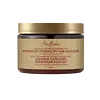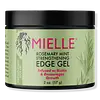What's inside
What's inside
 Key Ingredients
Key Ingredients

 Benefits
Benefits

 Concerns
Concerns

 Ingredients Side-by-side
Ingredients Side-by-side

Water
Skin ConditioningCetearyl Alcohol
EmollientCocos Nucifera Oil
MaskingButyrospermum Parkii Butter
Skin ConditioningGlycerin
HumectantStearyl Alcohol
EmollientBehentrimonium Methosulfate
Cetyl Alcohol
EmollientParfum
MaskingBehentrimonium Chloride
PreservativePanthenol
Skin ConditioningMangifera Indica Seed Butter
Skin ConditioningTrichilia Emetica Seed Butter
EmollientAdansonia Digitata Seed Oil
EmollientHydrolyzed Rice Protein
Skin ConditioningHydrogenated Vegetable Oil
EmollientPersea Gratissima Oil
Skin ConditioningTocopheryl Acetate
AntioxidantHoney
HumectantCetrimonium Chloride
AntimicrobialFicus Carica Fruit/Leaf Extract
Skin ConditioningTocopherol
AntioxidantGlycine Soja Oil
EmollientPropanediol
SolventCaprylyl Glycol
EmollientCaprylhydroxamic Acid
Benzoic Acid
MaskingWater, Cetearyl Alcohol, Cocos Nucifera Oil, Butyrospermum Parkii Butter, Glycerin, Stearyl Alcohol, Behentrimonium Methosulfate, Cetyl Alcohol, Parfum, Behentrimonium Chloride, Panthenol, Mangifera Indica Seed Butter, Trichilia Emetica Seed Butter, Adansonia Digitata Seed Oil, Hydrolyzed Rice Protein, Hydrogenated Vegetable Oil, Persea Gratissima Oil, Tocopheryl Acetate, Honey, Cetrimonium Chloride, Ficus Carica Fruit/Leaf Extract, Tocopherol, Glycine Soja Oil, Propanediol, Caprylyl Glycol, Caprylhydroxamic Acid, Benzoic Acid
Water
Skin ConditioningCeteareth-25
CleansingGlycerin
HumectantPEG-7 Glyceryl Cocoate
EmulsifyingPEG-40 Hydrogenated Castor Oil
EmulsifyingPropylene Glycol
HumectantEthylhexylglycerin
Skin ConditioningOlea Europaea Fruit Oil
MaskingMentha Piperita Oil
MaskingRosmarinus Officinalis Leaf Oil
MaskingEquisetum Arvense Extract
AstringentOrbignya Oleifera Seed Oil
EmollientZingiber Officinale Root Oil
MaskingCocos Nucifera Oil
MaskingHoney
HumectantBiotin
AntiseborrhoeicLawsonia Inermis Extract
AntimicrobialRosmarinus Officinalis Extract
AntimicrobialHumulus Lupulus Extract
AntimicrobialUrtica Dioica Extract
AstringentPhenoxyethanol
PreservativeAnthemis Nobilis Flower Extract
MaskingSymphytum Officinale Callus Culture Extract
Skin ConditioningBenzoic Acid
MaskingGlycereth-2 Cocoate
EmulsifyingParfum
MaskingWater, Ceteareth-25, Glycerin, PEG-7 Glyceryl Cocoate, PEG-40 Hydrogenated Castor Oil, Propylene Glycol, Ethylhexylglycerin, Olea Europaea Fruit Oil, Mentha Piperita Oil, Rosmarinus Officinalis Leaf Oil, Equisetum Arvense Extract, Orbignya Oleifera Seed Oil, Zingiber Officinale Root Oil, Cocos Nucifera Oil, Honey, Biotin, Lawsonia Inermis Extract, Rosmarinus Officinalis Extract, Humulus Lupulus Extract, Urtica Dioica Extract, Phenoxyethanol, Anthemis Nobilis Flower Extract, Symphytum Officinale Callus Culture Extract, Benzoic Acid, Glycereth-2 Cocoate, Parfum
 Reviews
Reviews

Ingredients Explained
These ingredients are found in both products.
Ingredients higher up in an ingredient list are typically present in a larger amount.
Benzoic Acid is used to preserve and adjust the pH of products.
The antimicrobial property of Benzoic Acid helps elongate a product's shelf life. Its main role is to reduce fungi growth and is not found to be effective at fighting bacteria. Therefore Benzoic Acid is always added along with other preservatives.
In its pure form, Benzoic Acid looks like a white crystalline solid. It has slight solubility in water.
The name of Benzoic Acid comes from gum benzoin, which used to be the sole source of deriving this ingredient. Benzoic Acid is the most simple aromatic carboxylic acid.
Benzoic Acid is naturally occuring in strawberries, mustard, cinnamon, and cloves. It has a slight scent but is not considered to be a fragrance.
Learn more about Benzoic AcidCocos Nucifera Oil is obtained from the kernels of the coconut fruit. In other words, this is coconut oil.
Coconut Oil is rich in fatty acids with lauric acid making up the majority of these. It also contains linoleic acid. Due to this high fatty acid content, coconut oil helps trap moisture and soften skin.
Despite being antibacterial, coconut oil may not be great for acne-prone skin. It is comedogenic and may clog pores. This ingredient may not be safe for malassezia or fungal acne.
Note: Coconut Oil should not replace your sunscreen for UV protection. Studies show it only blocks about 20% of UV.
This oil is non-volatile and has a light scent.
The term 'fragrance' is not regulated in many countries. In many cases, it is up to the brand to define this term. For instance, many brands choose to label themselves as "fragrance-free" because they are not using synthetic fragrances. However, their products may still contain ingredients such as essential oils that are considered a fragrance.
Learn more about Cocos Nucifera OilGlycerin is already naturally found in your skin. It helps moisturize and protect your skin.
A study from 2016 found glycerin to be more effective as a humectant than AHAs and hyaluronic acid.
As a humectant, it helps the skin stay hydrated by pulling moisture to your skin. The low molecular weight of glycerin allows it to pull moisture into the deeper layers of your skin.
Hydrated skin improves your skin barrier; Your skin barrier helps protect against irritants and bacteria.
Glycerin has also been found to have antimicrobial and antiviral properties. Due to these properties, glycerin is often used in wound and burn treatments.
In cosmetics, glycerin is usually derived from plants such as soybean or palm. However, it can also be sourced from animals, such as tallow or animal fat.
This ingredient is organic, colorless, odorless, and non-toxic.
Glycerin is the name for this ingredient in American English. British English uses Glycerol/Glycerine.
Learn more about GlycerinHoney comes from bees. It is mainly made up of the sugars fructose and glucose.
Besides sugar, honey also contains amino acids, peptides, Vitamins A, C, and E. Vitamins A, C, and E.
As a humectant, honey is great at hydrating the skin. Humectants draw moisture from the air and hold it to your skin.
Honey also has antioxidant and antioxidant properties. Fun fact: darker honey has more antioxidants than light honey.
The antibacterial property of honey may make it effective at helping to treat acne. We recommend speaking with a professional if you have concerns.
Many people wonder if honey is vegan. It is technically a byproduct from bees. This is because honey is created from the digestive enzymes in a bee's stomach.
Remember to be kind to bees :) They are important for many ecosystems and are endangered.
Learn more about HoneyParfum is a catch-all term for an ingredient or more that is used to give a scent to products.
Also called "fragrance", this ingredient can be a blend of hundreds of chemicals or plant oils. This means every product with "fragrance" or "parfum" in the ingredients list is a different mixture.
For instance, Habanolide is a proprietary trade name for a specific aroma chemical. When used as a fragrance ingredient in cosmetics, most aroma chemicals fall under the broad labeling category of “FRAGRANCE” or “PARFUM” according to EU and US regulations.
The term 'parfum' or 'fragrance' is not regulated in many countries. In many cases, it is up to the brand to define this term.
For instance, many brands choose to label themselves as "fragrance-free" because they are not using synthetic fragrances. However, their products may still contain ingredients such as essential oils that are considered a fragrance by INCI standards.
One example is Calendula flower extract. Calendula is an essential oil that still imparts a scent or 'fragrance'.
Depending on the blend, the ingredients in the mixture can cause allergies and sensitivities on the skin. Some ingredients that are known EU allergens include linalool and citronellol.
Parfum can also be used to mask or cover an unpleasant scent.
The bottom line is: not all fragrances/parfum/ingredients are created equally. If you are worried about fragrances, we recommend taking a closer look at an ingredient. And of course, we always recommend speaking with a professional.
Learn more about ParfumWater. It's the most common cosmetic ingredient of all. You'll usually see it at the top of ingredient lists, meaning that it makes up the largest part of the product.
So why is it so popular? Water most often acts as a solvent - this means that it helps dissolve other ingredients into the formulation.
You'll also recognize water as that liquid we all need to stay alive. If you see this, drink a glass of water. Stay hydrated!
Learn more about Water